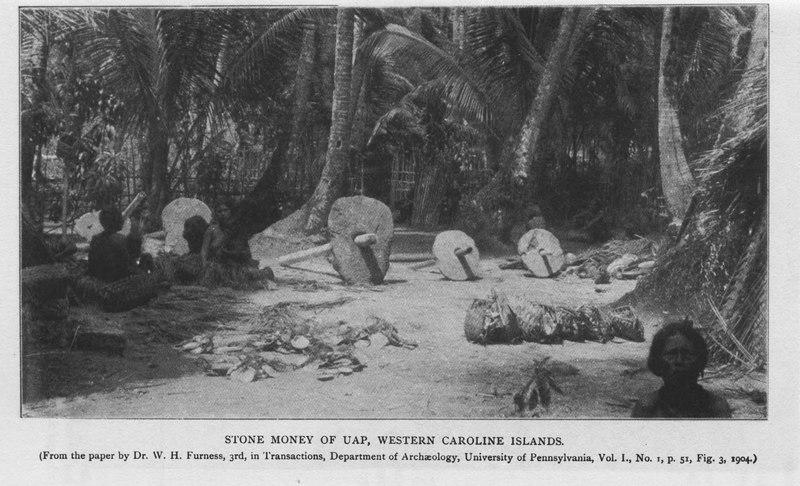A long time ago in Yap, the story goes, people were always arguing about trading and doing business, and what to accept as a method of payment.
A chief had an idea while looking at the full moon. He said – we should have something large, round and beautiful like the moon for trading, always there like the moon, something that doesn’t break or wear out or get stolen.
So, the villagers of Yap set out in their canoes to find that something. Some traveled almost 300 miles, to the island of Palau, where they found shimmering limestone. They carved disks of it, with a hole in the middle to let people carry it on poles, says John Runman, an oral historian at the Yap State Historical Preservation Society:
“If you look at stone money, it really looks like a full moon, the color of a full moon. And that’s what they say – the people went to get their chief the moon, and they didn’t succeed, so they gave him the next best.”
But this isn’t just any old money, he says – and not only because it takes 20 strong men to carry each of the heavier pieces.
“Stone money is not used to ask for a wife, for instance. That is something that we use shell money for. Stone money is something we can give to someone to build a house. It is something we can give to another family to ask for forgiveness, or as an apology for a wrongdoing a member of my family has caused onto the other family.”
The bank is in the middle of a forest. There are no bank windows, no tellers – not even a building – just disks of calcite and limestone, of various sizes, propped along a stone path, leading to a village.
The value of the money varies…..“It depends on the story, of how they got it here on the island. If it cost someone’s life to get it here, it is more valuable than these big ones.”
Sometimes the pieces are named after someone – someone who died, trying to bring it to the island, or someone who did some heroic deed that is retold every time the stone money changes hands.
In a culture of just a few thousand people, without a written language, the stories behind the stone money are part of Yap’s living history.
Stone money is still used in Yap, a 74-year-old gentleman, James Lukan talked about his stone money:
“Yeah, I have stone money. I had one given to me when I married my wife, and my wife’s family gave it to my father, and they still have it in the village, my wife’s village. And they still know… That it belongs to me.”
Form and value
Rai stones are circular disks carved out of limestone with a large hole in the middle. The size of the stones varies widely; the largest are 3 meters (10 ft) in diameter, 0.5 meters (1.5 ft) thick and weigh 4 metric tons (8,800 lb).
The extrinsic (perceived) value of a specific stone is based not only on its size and craftsmanship but also on the history of the stone. If many people — or no one at all — died when the specific stone was transported, or a famous sailor brought it in, the value of the rai stone increases.
Rai stones were used in social transactions such as marriage, inheritance, political deals, sign of an alliance, ransom of the battle dead or just in exchange for food. Many of them are placed in front of meetinghouses or specific pathways. Though the ownership of a particular stone changes, the stone itself is rarely moved. The names of previous owners are passed down to the new one.
History
Yapese quarried the limestone rocks from the islands of Palau and took them to Yap with canoes and rafts. Local legend holds that the Yapese discovered the rock of Palau about 500–600 years ago when an expedition led by a man called Anagumang landed on Palau. Limestone was nonexistent in Yap and therefore very valuable to the Yapese.
First Anagumang ordered his men to cut stone into the shape of fish but eventually a circular shape was chosen, probably because it was easier to transport. A pole was put through the hole in the center of the stone so that laborers could carry the stone. The largest of the disks probably needed hundreds of men to transport.
Residents of Palau, in turn, required Yapese to pay in beads, coconut meat and copra or in the form of services for the privilege of quarrying.
In 1871 an Irish-American David Dean O'Keefe was shipwrecked near Yap and was helped by the natives. Later he assisted the Yapese in acquiring rai and in return received copra and trepang, which were valuable exports in the Far East.[1] He provided the Yapese with iron tools. As a result, a form of inflation set in and rai stones acquired with his help were less valuable than more ancient ones.
In one instance, a rai being transported by canoe was accidentally dropped and sunk to the sea floor. Although it was never seen again, everyone agreed that the rai must still be there, so it continued to be transacted as genuine currency - perhaps the ultimate expression of fiat money.
The trade for rai stones eventually stopped at the beginning of the 20th century due to trade disputes between Spanish and German interests in the area. Quarries were abandoned. When Imperial Japanese forces took over Yap during World War II, they used some of the stones for construction or as anchors.
Although Western-style money has replaced the stones as everyday currency, the rai stones are still exchanged in traditional ways between the Yapese. They are a national symbol and are depicted on local license plates.
References:


No comments:
Post a Comment